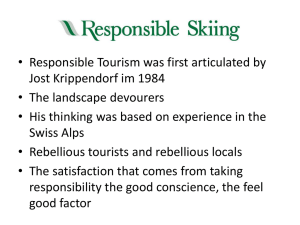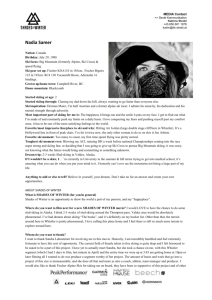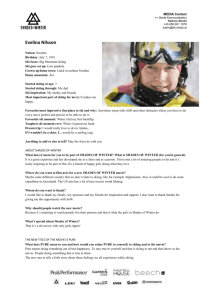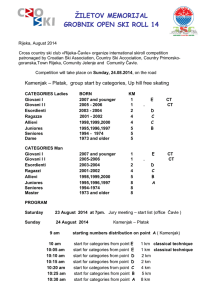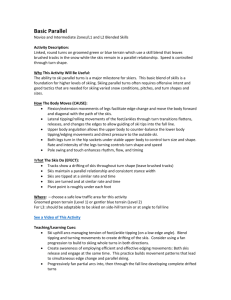Zone Heart Rate Range Goal Difficulty
advertisement
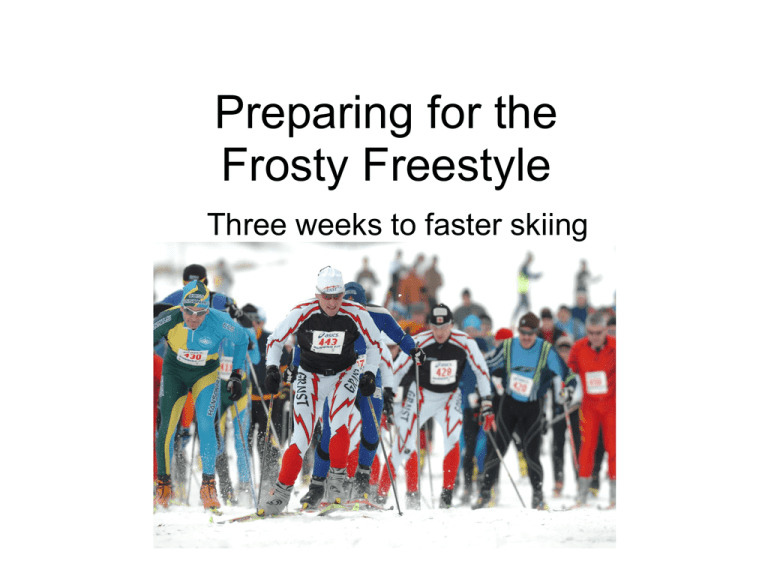
Preparing for the Frosty Freestyle Three weeks to faster skiing Coach and Cheerleader Mike Muha • A struggling masters skier, juggling work, family, training and racing. • Race Director for Frosty Freestyle • Keeper of http://www.NordicSkiRacer.com mike.muha@NordicSkiRacer.com Cell: 248-535-9351 Three weeks to skiing faster Week 1 Fitness Week 2 Technique Week 3 Gear & Strategy Getting in the right zone Classic technique The fastest way to get fit Skate technique Strength training - where it counts The single most important technique Classic vs. skating: differences in boots, skis, poles, bindings Making it specific Pole length Roller skiing? Do I need to stay in the tracks? But I have no time to train! Downhills Strategies for your first race Corners Skiing in a group Passing and being passed How to race smarter Fish scales vs. “the hairies” Fashion and function Week 1: Fitness Fitness • Training zones • Strength: Abs, core, upper body • Dryland training • Rollerskiing • Transition, dryland to snow • Where to train/ski The uniqueness of skiing • • • • Full body exercise Constant state of imbalance Technical skills Equipment skills Training Levels or Zones Zone Heart Rate Range Goal Difficulty 1 60-70% Increase aerobic efficiency Very easy to talk 2 70-80% Increase aerobic efficiency Easy to talk 3 80-90% Increase work capacity at Lactate Threshold Hard to talk 4 91-95% Increase VO2 Max (Maximal aerobic capacity) Very hard to talk 5 95-100% Increase anaerobic capacity Cannot talk 6 NA Increase biomechanical efficiency at speed NA Zone 1: Distance Training • Distance training – Get tired from length of session NOT intensity – It should be very easy to talk • Benefits – Increases cardiac efficiency – Increases capillarisation – Increases fat burning efficiency Zone 1: Distance Training • 90 minutes + • Ski, rollerski, running, biking, hiking • If skiing/rollerskiing: Use good technique – Practice makes permanent • Very hard to go this slow! • Ideal for high volume training • Less ideal for skiers with limited training time Zone 1: Recovery • Easy 20-30 minutes • Recovery after a hard day or session. • Get the lead out. Zone 2: Endurance / Technique • • • • • 30-90 minute distance sessions To be avoided if doing high volume training OK or recommended for low volume training Use for technique training Level 2 “happens” during Level 1 sessions Zone 3: Threshold / Steady State • Improve aerobic efficiency and aerobic capacity • Sample sessions – – – – Time Trial (NOT all out effort) 3x8 minute, 4x6 minute intervals Increase length as you get in better shape Rest 1-3 minutes between intervals • Should feel like you can go faster or longer. • Best on skis, rollerskis, or ski walking Zone 4: Max VO2 Training • • • • Improve VO2 max & max aerobic work capacity Think “heart” training Intervals: 3-6 minutes, rest 3 minutes. Examples: – 3x3, 3x4, 4x4 intervals – Add more/longer intervals as fitness increases – These are HARD. Must be rested to have a quality session. Zone 5: Anaerobic • How often to do go anaerobic in a DISTANCE ski race? • Forget about ‘em… Zone 6: Speed • • • • Improve maximum velocity Must be fresh Skiing or rollerskiing only Sample session: – 5-10 intervals x 8-10 seconds, 2-3 minute rests – All out fast! • Practice on flats, uphills, downhills, transitions Anatomy of an interval session Tips on Zone 3/4 interval training • Slowly build up speed over first 1-2 minutes – Takes that long for body to adjust – Reduces buildup of lactate • Same distance or longer on each interval • If the intervals get slower, – You started too hard – You’re going too long for you’re current level of fitness • Stop if intervals degrade or recovery is difficult Quality vs. Quantity! • Focus on Quality workouts: – – – – 1-3 interval sessions per week 1 distance session (considered a hard session) Everything else is easy! Must be well rested to do quality intervals • DON’T JUST HAMMER! (you’re really just going medium) Training time • Only have 1-2 hours a week? – – – – Workouts should have a “hard” component Zone 3 intervals Zone 2-3 distance sessions Zone 1: worthless Training tips • • • • Hills are your friends! Don‘t have rollerskis? Ski walk Train to train harder Specific training is best Ski walking / Bounding Ski walking / bounding • Ski walking – One foot is always on the ground – Emulates diagonal stride – Distance and interval training • Ski bounding – Both feet off the ground during bound – Explosive diagonal stride – Specific strength Rollerskiing • Most specific (after skiing) • Skate rollerskis: – – – – Shorter: easier to maneuver, safer Longer: feel more like skis Lighter: Better for technique 100mm diameter wheels best Rollerskiing • Classic Rollerskis: – – – – – Longer than long skate rollerskis Lighter = better technique Bigger wheels = better ride (but heavier) 70mm diameter good compromise Doublepole or kick-doublepole only (unless you KNOW you have good diagonal stride technique) Rollerskiing • • • • • • Helmet – always! Many have brake / speed reducer option Fenders are nice Buy ferrules for ski poles Sharp tips make rollerskiing much easier Act like a bicycle – same side as traffic Strength Training Strength: Core vs. Abs • Skiing is UNSTABLE! • Using arms and legs for balance… …reduces their use for forward momentum • Core muscles stabilize: – Transverse Abdominus – Wraps horizontally around the abdominal area – Used to stabilize the spine… …and to stay upright on skis Strength: Core vs. Abs • Abs – Rectus Abdominus (“six pack”) – Run vertically – Used in crunches… …and to propel you forward. • Faster skiers make extensive use of abs… …and strong abs will make you a faster skier Drills: Core and Abs • Core: – Planks: side, front, back – Supermans and Jane Fonda’s – Twists • Abs – Crunches of various sorts… – Bicycles General Strength: Lower body • • • • • Step ups Lateral jumps with touch Single legs hops: distance or height Squats Broad jump General Strength: Upper body • • • • Push ups Arm recovery Dips If you have bands: – Doublepole – Single stick (diagonal stride) Assignment! • 1 or 2 intervals sessions: – 3x3 minutes, fixed distance • 2 or 3 strength sessions: Core: • Planks • Supermans • Jane Fonda’s Abs: • Crunches, feet on ground • Crunches, feet on chair • Bicycles Other: • Dips • Push-ups • Step-ups • Skate with touch • Pole recovery
